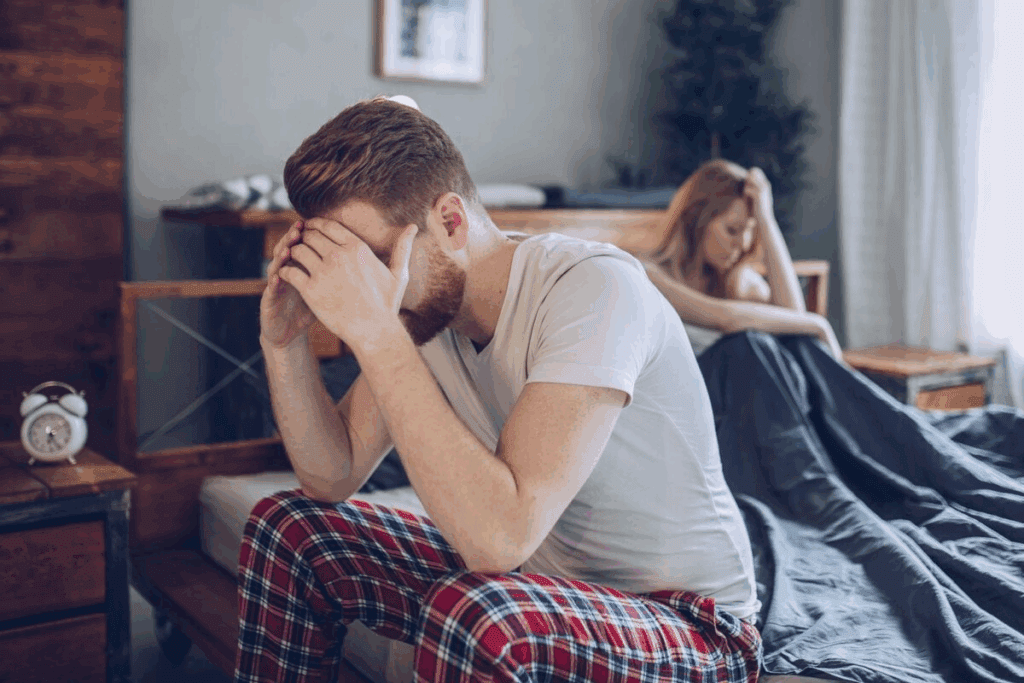Last Updated on November 27, 2025 by Ugurkan Demir

At Liv Hospital, we’re dedicated to top-notch healthcare for international patients. Advanced radiation seed therapy is changing prostate cancer treatment. It delivers healing right where it’s needed.
Brachytherapy, or seed implantation, uses tiny radioactive seeds. Each seed is about the size of a grain of rice. They’re placed in the prostate gland. This method lets patients go home the same day, with better results and fewer side effects.
We value precision medicine and care that puts patients first in oncology. By placing seeds in the prostate, this treatment protects healthy tissues. It’s a big step forward in fighting cancer.
Learn how radiation seeds (brachytherapy) are utilized to deliver a high dose of targeted radiation therapy for prostate cancer.

Prostate cancer is a big worry for men all over the world. It’s important to know about the disease and how to treat it. Learning about prostate cancer helps men manage and treat it better.
Prostate cancer happens when cells in the prostate gland grow too much. The prostate gland is a small gland below the bladder. It makes seminal fluid to help sperm.
Many things can increase the risk of prostate cancer. These include age, family history, and ethnicity. Men over 50 and those with a family history are at higher risk.
Early detection is key for good treatment. Tests like PSA and DRE help find cancer early.
Treatment for prostate cancer depends on the cancer’s stage and risk factors. It also depends on the patient’s health. Options include active surveillance, surgery, radiation therapy, and seed implants prostate cancer (brachytherapy).
Radiation therapy kills cancer cells with high-energy rays. Prostate seeding or brachytherapy puts small radioactive seeds in the prostate gland.
“The choice of treatment depends on several factors, including the stage and aggressiveness of the cancer, as well as the patient’s preferences and overall health.”
— American Cancer Society
It’s vital for patients to know about these treatments. This knowledge helps them make informed choices. By understanding the options, men can work with their doctors to find the best treatment.

Seed therapy is a new way to treat prostate cancer. It involves placing small radioactive seeds in the prostate gland. This method, known as brachytherapy, targets the tumor with high doses of radiation. It does this while keeping healthy tissues safe.
We will dive into the details of this treatment. We’ll look at its definition, how it works, its history, and the types of seeds used.
Seed therapy, or brachytherapy, is a type of internal radiation. Tiny radioactive seeds or pellets are placed in or near the prostate tumor. These seeds kill cancer cells, and the method aims to protect healthy tissues.
The main idea is to give a high dose of radiation right to the cancer. This makes the treatment more effective and reduces side effects.
Brachytherapy started in the early 20th century, after Marie Curie found radium in 1898. At first, it used radium needles in tumors. Over time, it evolved with new technology and isotopes.
In the 1980s, ultrasound-guided techniques made seed placement more precise. This made brachytherapy a better option for prostate cancer treatment.
Iodine-125 (I-125) and Palladium-103 (Pd-103) are the main isotopes for seed therapy. I-125 is for lower-risk prostate cancer, and Pd-103 is for higher-grade tumors.
These isotopes have different lifespans and radiation types. Doctors choose the best one for each patient based on their cancer and health.
Prostate brachytherapy is a precise treatment for prostate cancer. It uses tiny radioactive seeds placed in the prostate gland. This method delivers targeted radiation therapy.
The seeds in prostate brachytherapy give off low doses of radiation for months. This slow release attacks cancer cells while protecting healthy tissues. The seeds stay in the prostate forever but lose their radioactivity quickly.
A leading oncologist says, “Radioactive seeds in brachytherapy are a big step forward for treating prostate cancer. They offer a strong treatment with fewer side effects than old methods.”
“Brachytherapy’s precision in treating prostate cancer is unmatched. It offers a custom radiation therapy that kills cancer cells well while saving healthy tissue.”
The process of using brachytherapy seeds is well-planned. The time it takes for the seeds to deliver radiation varies. Usually, it’s weeks to months, making sure cancer cells are killed.
| Timeline | Radiation Level | Treatment Progress |
| 0-30 days | High | Initial treatment phase, high radiation dose |
| 30-60 days | Moderate | Continued radiation therapy, cancer cell death |
| 60+ days | Low | Radiation levels decrease, treatment completion |
The seeds are placed in the prostate to hit cancer cells hard but spare healthy tissue. Their radiation messes up cancer cells’ DNA, stopping them from growing and killing them.
The precision of seed placement is key for success. Advanced imaging helps doctors place the seeds right. This ensures the best radiation to the tumor.
In conclusion, prostate brachytherapy is a precise and effective way to fight prostate cancer. Knowing how radiation seeds work helps patients choose the best treatment.
To get seed implantation, patients need to meet certain criteria. These include the cancer stage, prostate size, and overall health. Not everyone with prostate cancer can have this treatment. A detailed check is needed to see if it’s right for you.
The stage and grade of prostate cancer are key in deciding if seed implantation is right. This treatment works best for early-stage cancer that stays within the prostate.
The size and shape of the prostate gland matter for seed implantation. A prostate that’s too big or too small can make the procedure hard.
Some health conditions can make seed implantation less likely. These include:
Choosing seed implantation involves talking with your doctor. This includes:
Healthcare providers carefully look at these factors to decide if seed implantation is the best choice for you.
The seed implantation process is complex and requires great skill. We will guide you through each step, from preparation to the actual procedure.
Before starting, we do thorough tests to see if you’re right for brachytherapy. We check your health, prostate size, and cancer stage. We also use ultrasound to plan where the seeds will go.
Getting ready is important for the procedure’s success. We’ll give you clear instructions on what to do, like diet changes and medication adjustments.
The actual process uses advanced imaging techniques like ultrasound to place the seeds. This is done under local anesthesia or light sedation to keep you comfortable.
We insert the seeds through needles into the prostate. We follow a plan to make sure the cancer gets the right amount of radiation.
The number and placement of seeds depend on your prostate size and cancer extent. We aim to give the tumor the right dose of radiation while protecting healthy tissues.
The procedure usually takes one to two hours. We offer different anesthesia options to keep you comfortable, from local anesthesia to mild sedation.
After the procedure, we watch you for a bit before you go home. You’ll get instructions on how to manage any side effects and ensure a smooth recovery.
Recovering after seed implantation means following certain steps to avoid side effects and stay safe from radiation. We’ll walk you through what to do after the procedure.
Most people can go home the same day. But, some might need to stay overnight for extra checks. This depends on your health and the treatment details. We give you clear instructions on how to care for yourself after going home.
Make sure someone drives you home. You might feel drowsy from the anesthesia. Our team will make sure you’re okay before you leave.
After the procedure, you might feel the need to pee a lot or feel some pain. We can give you medicine to help with these issues. Fatigue is also common but should get better in a few days.
To deal with these side effects, try the following:
It’s important to avoid heavy lifting, bending, or hard exercise for a while. Also, wait for your doctor’s okay before having sex again. These steps help prevent complications and keep the treatment working well.
Following these rules is key to avoiding problems and making sure the treatment is effective.
The seeds used in the treatment are safe for most people, but we recommend some precautions. For a short time, you might want to avoid being too close to pregnant women and young kids. The seeds give off low levels of radiation that decrease over time.
We’ll give you specific advice on how to stay safe from radiation at home and in public.
Doctors stress that following the post-procedure guidelines is vital for a smooth recovery. Keeping in touch with your healthcare team is also important.
“The care received after the procedure is just as important as the procedure itself. By following the recommended guidelines, patients can significantly improve their recovery experience.”
Medical Expert, Radiation Oncologist
| Post-Procedure Care Aspect | Recommendations |
| Hospital Stay | Usually same-day discharge; some may require overnight stay |
| Managing Side Effects | Medications for urinary issues; rest to alleviate fatigue |
| Activity Restrictions | Avoid heavy lifting, bending, strenuous exercise, and sexual activity as advised |
| Radiation Safety | Limit close contact with pregnant women and young children; follow specific guidance |
It’s important for patients to know about the side effects of seed implantation for prostate cancer. Seed therapy is a good way to treat prostate cancer. But, it can cause side effects that affect a patient’s life quality.
Urinary problems are common after seed implantation. Patients might have to go to the bathroom more often or have trouble urinating. These issues are usually short-term but can last for some people. Bowel problems, like rectal pain or bleeding, can also happen because of the prostate’s location.
To deal with these issues, patients can try different things. Medications can help with urinary problems, and changing what you eat can ease bowel discomfort. It’s key to see your healthcare provider regularly to manage these side effects well.
Sexual problems are another side effect of seed implantation. Patients might have trouble getting an erection or feel less interested in sex. How much these problems affect you can depend on your age, how you were before, and the treatment details.
There are ways to handle sexual problems, like medicines or other treatments. Talking to a healthcare provider can help find the best option for you.
Seed implantation is usually safe, but there are long-term health risks to think about. These include a small chance of getting another cancer. It’s important to keep up with regular check-ups and care to catch and manage any long-term effects.
It’s important for patients to know when to get help. If you have heavy bleeding, severe pain, or trouble urinating, you need to see a doctor right away. Regular visits to your healthcare provider can help spot and handle side effects early.
| Side Effect | Management Strategies | When to Seek Medical Attention |
| Urinary Issues | Medications, lifestyle adjustments | Severe pain, inability to urinate |
| Bowel Discomfort | Dietary changes, medications | Rectal bleeding, severe discomfort |
| Sexual Dysfunction | Medications, counseling | Significant impact on quality of life |
Knowing about the side effects of seed implantation and how to handle them helps patients through their treatment. It’s vital to talk openly with healthcare providers about any concerns or symptoms.
Seed therapy has seen big improvements in treating prostate cancer. This has made it a hot topic in the medical world. We’ll look at how well seed therapy works compared to other treatments, what affects its success, and how patients do long-term.
Research shows brachytherapy is as good as surgery or external beam radiation for some prostate cancer patients. The choice depends on the patient’s health, cancer stage, and what they prefer.
Key comparisons include:
Studies say seed therapy is effective and easy to handle. For example, a study found brachytherapy is as good as surgery for low-risk prostate cancer.
Several things affect how well seed therapy works:
Getting the dosing right and choosing the right patients are key. Experienced centers do better because they’re more skilled and have better care plans.
Long-term studies show seed therapy can control cancer well and lead to high survival rates. For instance, a study found patients treated with brachytherapy had great cancer control and survival, just like other treatments.
New research is making seed therapy even better. It’s looking at new isotopes, better dosing, and combining treatments. These changes aim to make brachytherapy more effective and less harsh. As research keeps going, we’ll see even better treatments for prostate cancer.
When thinking about seed therapy for prostate cancer, knowing the costs and insurance details is key. The financial side of treatment is a big worry for many.
The cost of brachytherapy in the U.S. changes based on several things. These include the treatment center, the doctor’s team, and the patient’s needs. On average, seed implantation can cost between $15,000 and $30,000 or more. This includes the procedure, hospital stay, and follow-up care.
| Cost Component | Average Cost | Range |
| Procedure and Hospital Stay | $18,000 | $10,000 – $25,000 |
| Radioactive Seeds | $5,000 | $3,000 – $7,000 |
| Follow-up Care | $2,000 | $1,000 – $3,000 |
| Total | $25,000 | $15,000 – $35,000 |
Most health insurance plans, including Medicare, cover brachytherapy for prostate cancer. But, how much they cover can differ a lot. It’s important for patients to check their insurance and know what they might have to pay out of pocket.
Tips for Understanding Insurance Coverage:
When talking to your healthcare provider about seed therapy, ask the right questions. This will help you understand the costs and what to expect.
Finding a treatment center with experience in prostate brachytherapy is key for the best results. Look for centers that specialize in this treatment and have a good reputation.
Consider the following when selecting a treatment center:
Finishing prostate seed therapy is a big win for those fighting prostate cancer. Brachytherapy is a top-notch treatment that puts tiny radioactive seeds in the prostate. This method is very effective.
After treatment, patients are watched closely for how they react and any side effects. Most men can get back to their usual life in a few days. They just need to be careful about not exposing others to radiation. Knowing what to expect after seed therapy helps manage hopes and ensures a smooth recovery.
During recovery, some side effects like urinary or bowel problems might happen. But, these can usually be handled with doctor’s advice. It’s key to keep up with regular check-ups with healthcare providers. This helps make sure the treatment is working and tackles any worries.
Brachytherapy for prostate cancer works well, and many men can live a normal life after it. Understanding what recovery and life after treatment are like helps patients on their healing path. This way, they can improve their quality of life.
Prostate cancer seed therapy, also known as brachytherapy, is a treatment. Small radioactive seeds are placed in the prostate gland to fight cancer.
It delivers radiation directly to cancer cells through seeds. This method helps protect healthy tissues nearby.
Seed therapy targets cancer cells well. It reduces harm to healthy tissues. Studies show it’s very effective against prostate cancer.
Being a candidate depends on several factors. These include cancer stage, prostate size, and overall health.
The procedure involves careful planning and execution. It includes testing, the implantation process, and post-care.
Side effects can include urinary, bowel, and sexual issues. Long-term health effects are also possible. Proper care can manage these.
Seed therapy is very effective. Its success rates are similar to surgery and external radiation.
Costs vary, but in the U.S., they can be high. Insurance and reimbursement options help manage these costs.
Follow-up care includes regular check-ups. It ensures the treatment works and manages side effects.
Yes, recent advancements have improved treatment outcomes. These include better radiation delivery and seed placement.
Ask your healthcare provider for recommendations. You can also research reputable centers in your area.
Discuss the procedure, side effects, and outcomes with your provider. Also, ask about any concerns you have.
National Center for Biotechnology Information. (2025). How to Treat Prostate Cancer With Radiation Seeds. Retrieved from https://www.ncbi.nlm.nih.gov/pmc/articles/PMC2735748/
Subscribe to our e-newsletter to stay informed about the latest innovations in the world of health and exclusive offers!